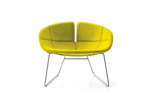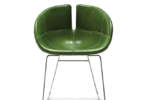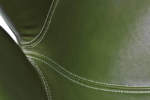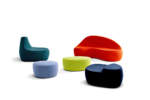Moroso leather system. Photo by Valentina Muscedra
Marco Casamonti: When we look at the Moroso materials, from the leathers to the fabrics, we see that they are not random choices, but that thought has been given to the colors. How much does the color belong to the inner workings of the project and, putting it simply, how much does the search for the right colors engage you from one project to another?
Patrizia Moroso: It has always been normal, and extremely logical for me, to dress the things I create in a specific way, not indifferently but appropriate to the object. I began working in the company in 1986, collaborating with Massimo Iosa Ghini, who was just a kid then, 22 years old, a student at the University of Florence with a passion for design and comics. The way we started out had an important influence on us from the beginning.
We were used to thinking of our objects as characters in the comics, as living creatures with a soul, spirit and character. Massimo’s collection was thus inspired by futurism and streetlife, his two great schools of thought, from which he then imagined his own current of thought called “bolidism”, which represented everything fast, that had a strong, instinctive outline, symbolic of streaking speed. Clearly, the colors were inspired by Futurism, to a great extent: they were cold shades like petroleum blue and those of America in the Forties and Fifties, crazy colors like pinks and yellows. Obviously, the surfaces had to be rather glossy too, and so we used a lot of leather: leather and iron pipes were very reminiscent of the avant garde movement and of Futurism, although they took the materials and colors from the avant garde movement, but not the shapes. The first collection was very strong and in total contradiction with the historic avant garde, the Bauhaus, etc.
The idea was to create a world, not just an object. To create a world we needed everything: shapes, upholstery and colors; all were equally important to give meaning to the products. In 1988 I worked with Toshiyuki Kita, the famous Japanese designer, and we made a piece, the Saruyama, that was a much longer lasting project than those of Iosa Ghini. Just imagine – Yoshiyuki brought me a plaster model and told me it was very precious because it was a model of his graduate thesis (from 1968) and that for him it was the archetype of all his work because when he thought about any new project he always started from there, the object that no one had ever wanted to produce but that he loved very much.
I thought it was wonderful and I wanted to produce it right away. In the Saruyama, the colors are fundamental. I already adored Japanese things and when this object was born, if there was a color that symbolized Japan, it was red, that was its conceptual color. So, although it is an organic object, it was also an object by Kita and one that came from Japan. It was red for a long time, but gradually he also acquired the colors of the earth and sand: it’s had a lot of grays and browns.
The word Saruyama means “monkey mountain”, and it symbolizes how monkeys, but also people, sit on rocks in various ways: it was a sort of rock that could have a corner on which to sit in the lotus position for meditation (like on a chair), with a zone where you could relax to read or even lie down. All these uses are clearly visible if you get a group of children and put them on this rock, they inhabit it: they teach us that human beings, before we had chairs and sofas, used to sit on a piece of rock or a branch.
M.C.: I have to confess that I am a fan of the Saruyama Island and I think that when we select it for a project, it’s impossible not to use color, in the sense that these rock are either all one color, all the same, or else we have to work on them in terms of color composition.
P.M.: That is exactly the deeper meaning of this project, that refers to organic design, not the American design of the Fifties, but to Japanese design. As you know, in Japan there are no formal objects for sitting. The interior of a house is a composition of essential geometry, with its rules and proportions, and you sit on the floor or on a small cushion, while perhaps observing a Zen garden outside, with the rocks artfully arranged in a natural space. Saruyama is what you see outside, controlled nature, arranged so as to be beautiful. It represents the relationship between architecture and nature. When I choose it for a project I automatically see it and include it, of course, as if it were part of the landscape: for example,
if the pieces are rocks, you will choose grays, and if you imagine them as pieces of wood you prefer browns, or they can be more pop and have more synthetic colors.
M.C.: In the case of the Antinori Winery, for example, working with colors, we needed elements that were still natural but that could contrast with its harmony and introduce new elements.
The colors of the Saruyama Island collection, but also the fabrics that you have in the various collections, basically harmonize with nature (the pastels, colors, etc.) but at the same time are innovative and introduce strong elements.
I used them because I could freely introduce, for example, colored rocks in the overall harmony. So we worked that way because I think color is very important, but I never overdo it. Among all the designers you have worked with, Massimo Iosa Ghini, Toshiyuki Kita, but also Ron Arad or Ross Lovegrove, who would you say devoted the most attention to the colors as an element of the project?
P.M.: It’s hard to say, because really, for us, it has always been a very important element, along with all the others. For example, Ron Arad, even back at the beginning of our collaboration in 1989, used to carry a mason’s big red and blue pencil around with him everywhere: the colors of his first collection were red, blue, black and gray (the color of polished steel) and he excluded all the others. That was his way of expressing his strong bitonal impulse. Ross Lovegrove, however, with whom we didn’t work much, created the “Supernatural”, which was supposed to have colors that reflected nature but also had an essence of abstraction. We created the colors together, choosing them later among the prints. It was immediately clear to both that it wasn’t a chair that could have pure colors. Just because of its natural shape, as if it were a leaf, to give it a color abstracted from nature gave it an uncoordinated, childish effect.
M.C.: The Supernatural is a rather gelatinous object that requires its own transparency, a depth of its own given by the material. This chair is almost an oxymoron, a natural object but made of plastic. For example, I particularly like the caramel color, but black is nice too, because black is absolute, the absence of color.
P.M.: I think I especially wanted the black Supernatural, because it resembles a piece of broken coal and because there still wasn’t a black plastic chair on the market. The sales department claimed it would never sell, and they felt the same way about the version with the holes, but 4-5 months after we put it on the market, when we monitored sales we realized that the version that sold the most was the black one with holes in the back.
We did a lot of testing and the ones I picked were the ones they considered “production rejects”. Passing from one color to another with the same machines, apparently the colors in the molten plastic get mixed and you see it on the first twenty pieces: they are sort of iridescent. At times it’s not random; I actually designed some chairs with iridescent colors, having them print three colors in sequence, so as to mix the caramel with turquoise, orange with black, etc. Obviously, this isn’t the normal sequence, because they usually start from the light colors to go on to the dark ones. These chairs, with mixed colors, are more natural to me because they show how the plastic material is distributed in a such a slender mold like the one for the back of the chair.
M.C.: Among the many leading companies in the world for quality of the design, I think Moroso is the most interesting company as regards attention to color.
For example, I’m fascinated by your collection of leathers and I always refer to them because the red is not really red, the orange is a special orange, the yellow is not exactly yellow, etc.
I imagine these choices come from you and not from your collaboration with a designer. P.M.: It’s a fundamental choice, like it is for the textile collection as well, and it takes place in two ways: on the one hand we have the project, and these are special creations for new models that need a language; we decide what the object will look like, whether it will be light or dark, etc….these are all choices that are made between the designer and me, with Giulio Ridolfo, who has been working with me for many years and is a friend, but also a person who specializes in color.
When I started working with him, it was right after a long relationship with Della Valle, doing the footwear colors. So the first thing we worked on together was the leather collection.
M.C.: Do you keep statistics of the success of the models on the market, also on the basis of color?
P.M.: Certainly. When I ask our webmaster for the statistics, I can know, for example, which fabric is most in demand, which he’ll tell me is the red wool weave.
M.C.: If you monitor statistics, can you tell that people's taste is moving toward natural colors? Do you have an awareness of moving toward a world in harmony with the environment?
P.M.: The red cloth was maybe a while ago: red was our symbol, our corporate color. I’m sure, however, that the fabrics that do best in sales are the cloth and woolen items because they are the fabrics that can have the most intense colors. The textile and color quality depends on the fiber you are working with and its ability to express a greater or lesser intensity of color: cotton, for example, is a cool fabric and it is difficult to use, unless you have a range of products like changeable slipcovers.
Obviously, we also have to think of the countries in the south of the world, where the demand is for cool fabrics and not for wool, but they don’t know that cool wool is the coolest fabric in the world, also used in the desert.
M.C.: I have to admit that I have been learning just in the last couple of since, since I met you, to use colors that I used to reject entirely.
I started to handle your beautiful swatchbooks and I understood that it was an element of the project. For example, for the auditorium of the Antinori Winery, I decided not to use chairs all one color the way I’d done before, but I thought of the vineyard and the leaves of various colors depending
on whether they are in shadow or in the light, and so I decided to use six or seven shades of green. Doing that, the meaning is clear and it’s a lot of fun. In that connection, are there any objects you’ve started to manufacture and that then once you see them with another fabric or another color made a totally different impression? Like a chair that, when you see it in red seems hard and arrogant and when you see it in another color looks soft and subtle? How does the color affect the prototype that comes out?
P.M.: I remember that the Fjord by Patricia Urquiola, with one small change, became the seating in your auditorium. When it came out it needed to be characterized. For her presentation, in 2000, Patricia had wanted it in black and white because the dual shell, one inside and one outside, had to be highlighted by two contrasting colors, as opposite as possible. It was that way for a long time. Of course, we got tired of it almost immediately and began to use browns and greens, trying for more harmony in the combinations, they way it happens in nature. This object has become a symbol of natural color combinations: for example, even the stitching is in the same shade, as if it were a leaf with its veins.
M.C.: What amazed me about the chairs for the Antinori Winery was the difficulty I had in choosing the colors for the inner shell, the stitching, the base, etc. I discovered that even the stitching is important, if it’s in the same color or a contrasting color, because it highlights the lines of force with which the leather is attached.
P.M.: The base and the stitching go together, rather like the stem and the internal veins. There are things that have to have a harmony, and the supreme harmony is in nature.
M.C.: It would be interesting to understand whether there is a geography of color, or whether there is a change in color preferences depending on the geographical zone. To understand how the environment in which they live changes people’s taste.P.M.: I often go down to check on production and place
a few bets with myself. For example, the other day I saw a Fjord, in yellow leather, inside and out, with the black base and stitching and I said: this is German!
Talking about preferences, for all the marvelous colors you can put on the market, black is the one with the highest demand, although fortunately not at the levels of the ‘80s-‘90s when the proportion between black and other colors was 85% to 15%.
If you see a Supernatural in red you hate it, like a piece by Ron Arad in pink. The color always reflects its creator, because he inevitably puts a little of himself into every project. We are thinking, for example, of the work of Tord Boontje, who was precious, and very important for the change from rather rigid industrial design to greater freedom of thought, without taboos about the use of pink, blue, green, the pastel colors and the shades of flowers. The latest generation of Japanese, with respect to Kita, has given priority to white, they are more “Japanized”.
M.C.: We work with the companies through a very deep relationship, never a superficial one, and we try to understand what we’re working on, what the production philosophy and even the philosophy of life are. I saw a fake Supernatural in Brazil once. How could I tell it was a fake? The shape was perfect, identical, because the mold had been copied by the Chinese, but they hadn’t copied the color: it was an orange that Moroso would never have chosen, and the quality of the plastic was not as good. There is definitely an identity in the combination of colors in your collection, that goes beyond the shape and the designer, but represents the DNA of Moroso. Recognizability is an important element for a company.
Patrizia Moroso, Moroso art director. Moroso was established in 1952 with the objective of making sofas, armchairs and furnishing accessories.
Nearly sixty years after its founding, Moroso is positioned among the haute couture of international design, a leading company in upholstered-furniture manufacturing.
Through the creative input of famous designers, Moroso has over the years created a collection of iconic designs and has become the first upholstered-furniture manufacturer to be granted ISO 9001 production process certification (in 1994) and, in 1999 ISO 14001 environmental management system certification. Today Moroso has 140 employees, a turnover of €30m and branches in the Usa, Great Britain and Singapore.









